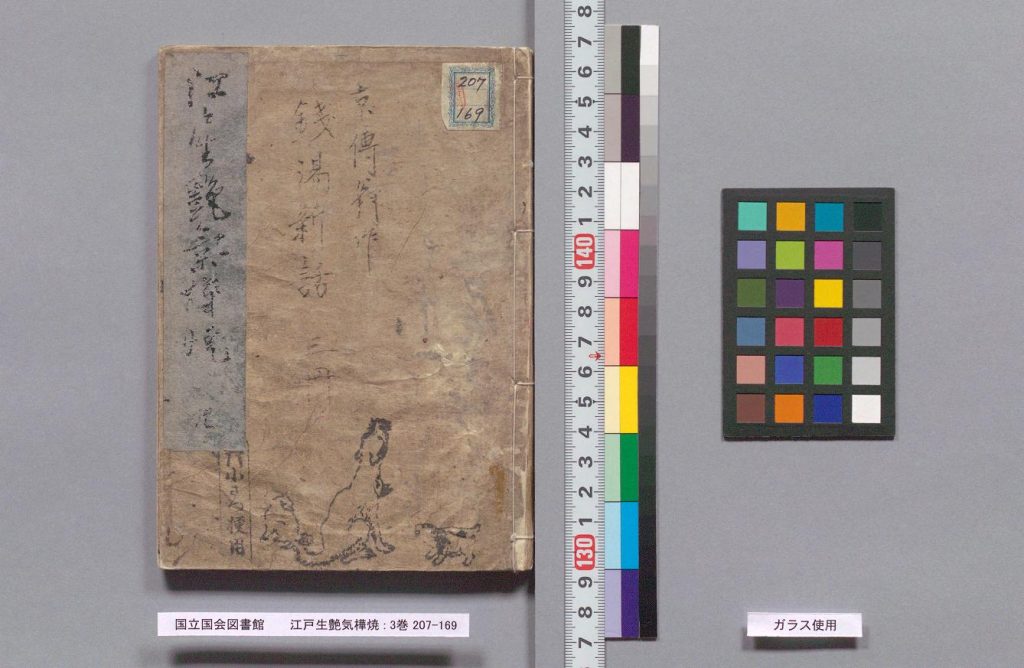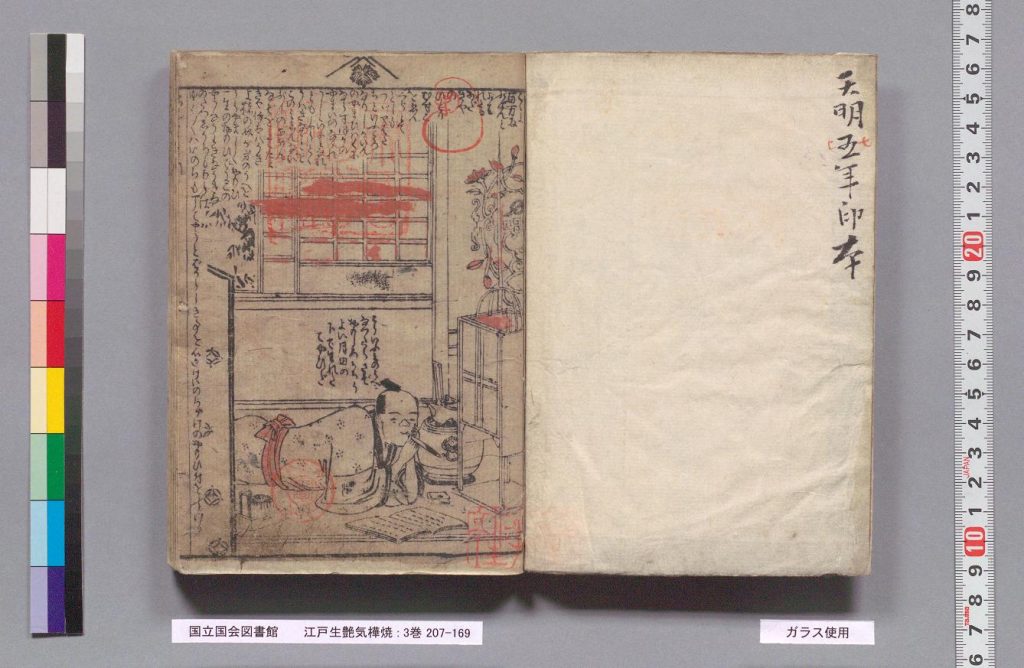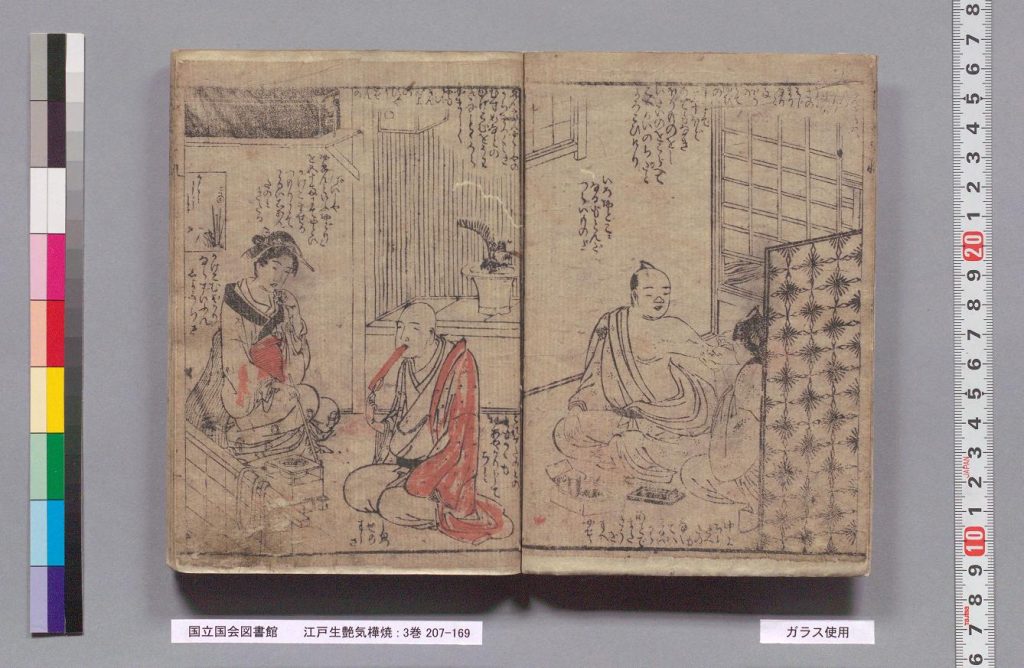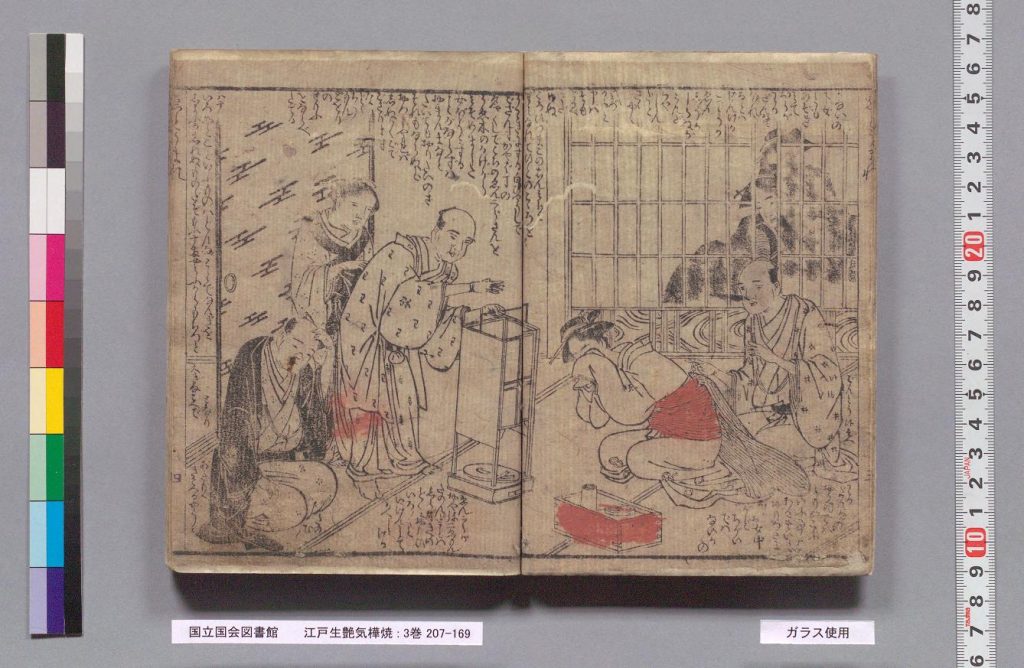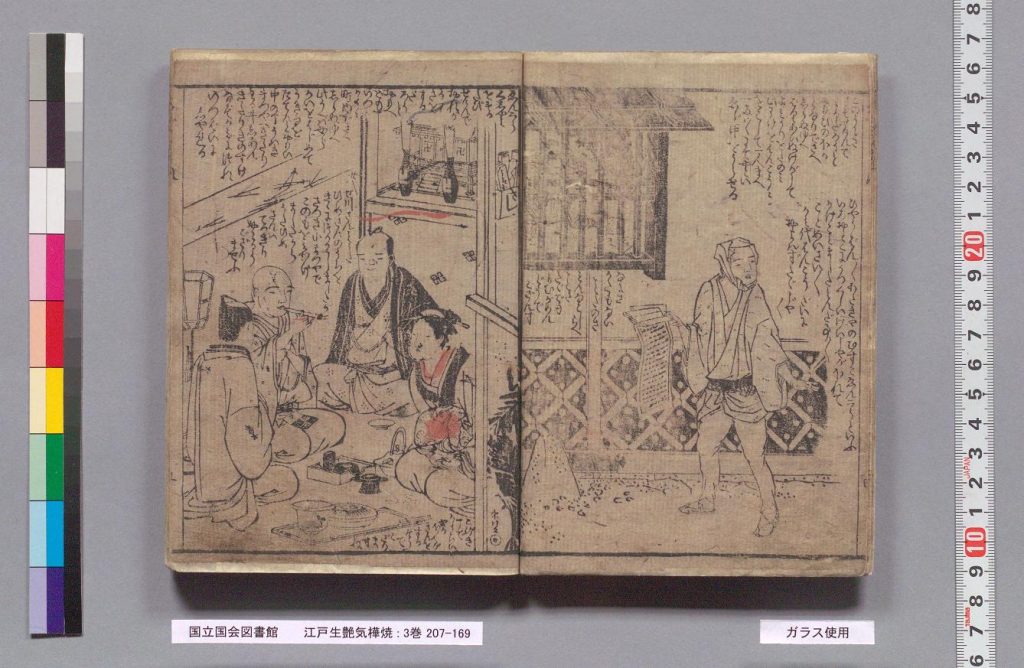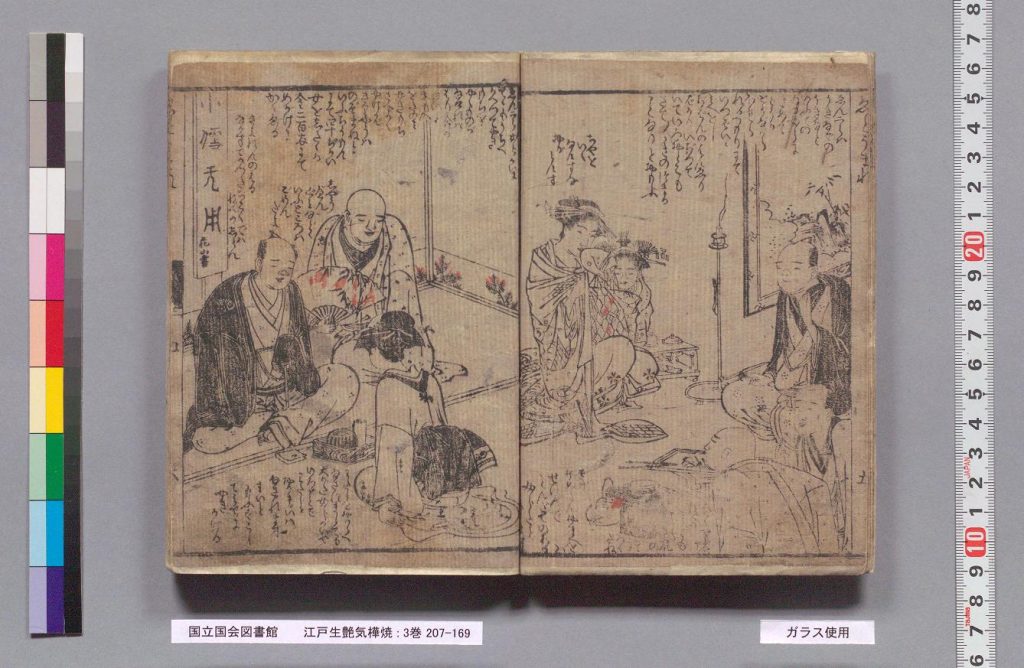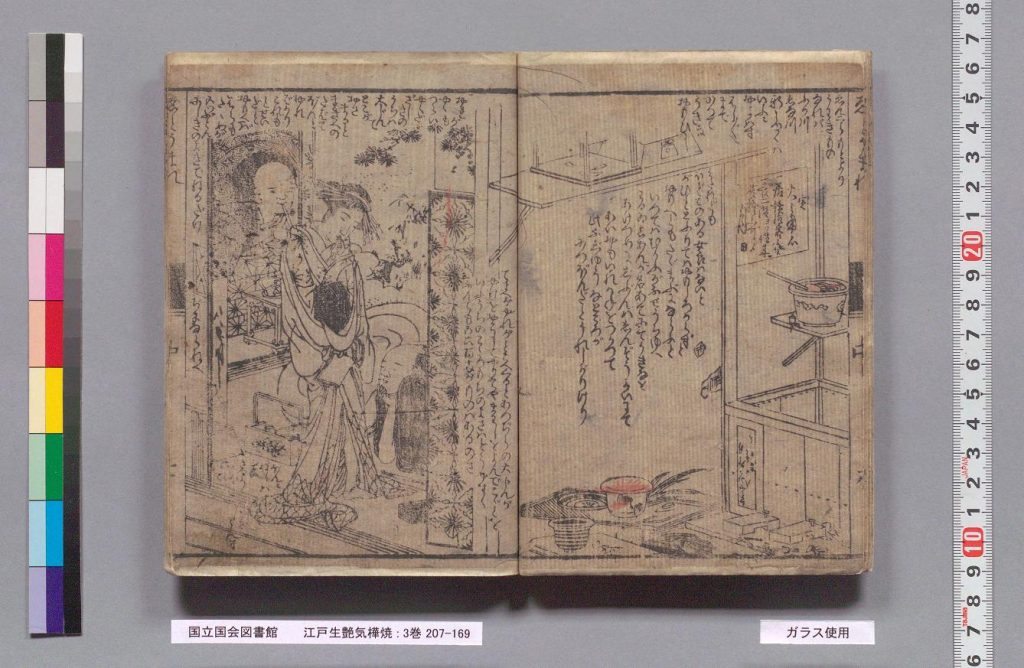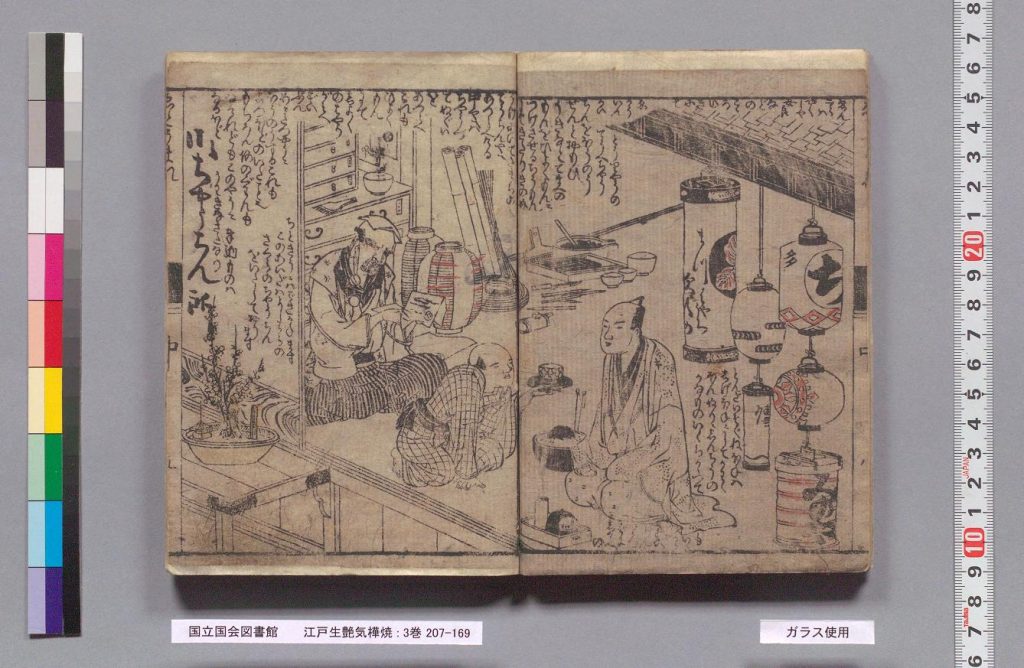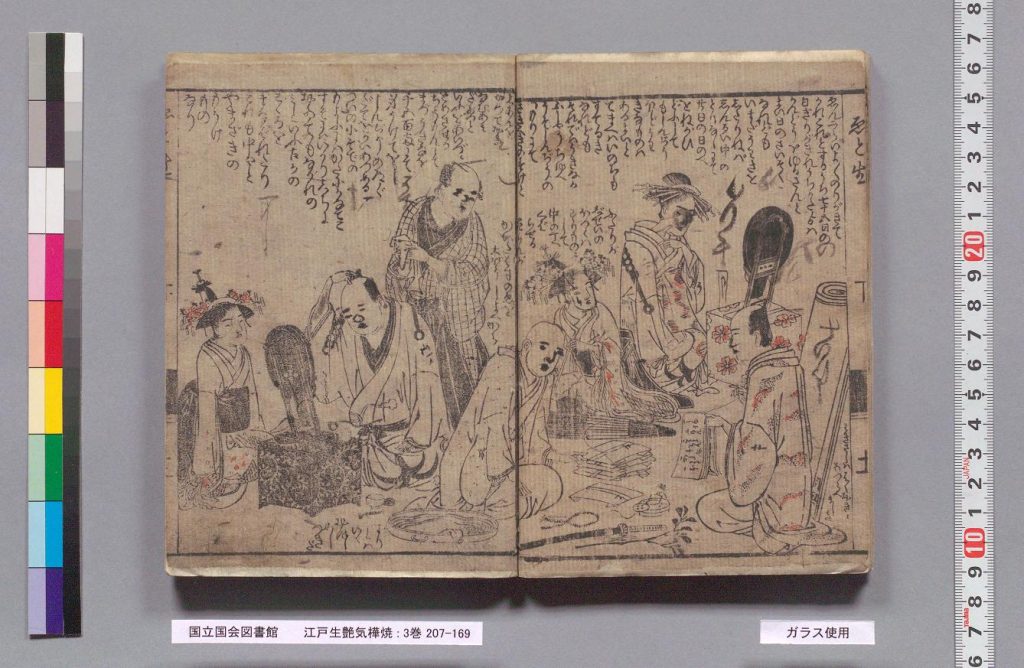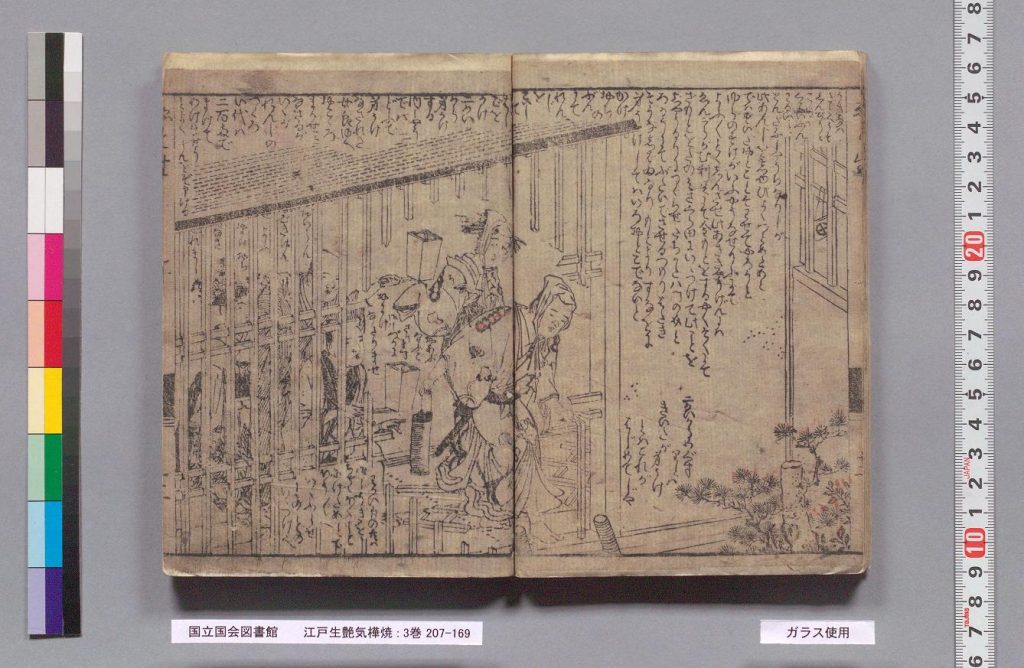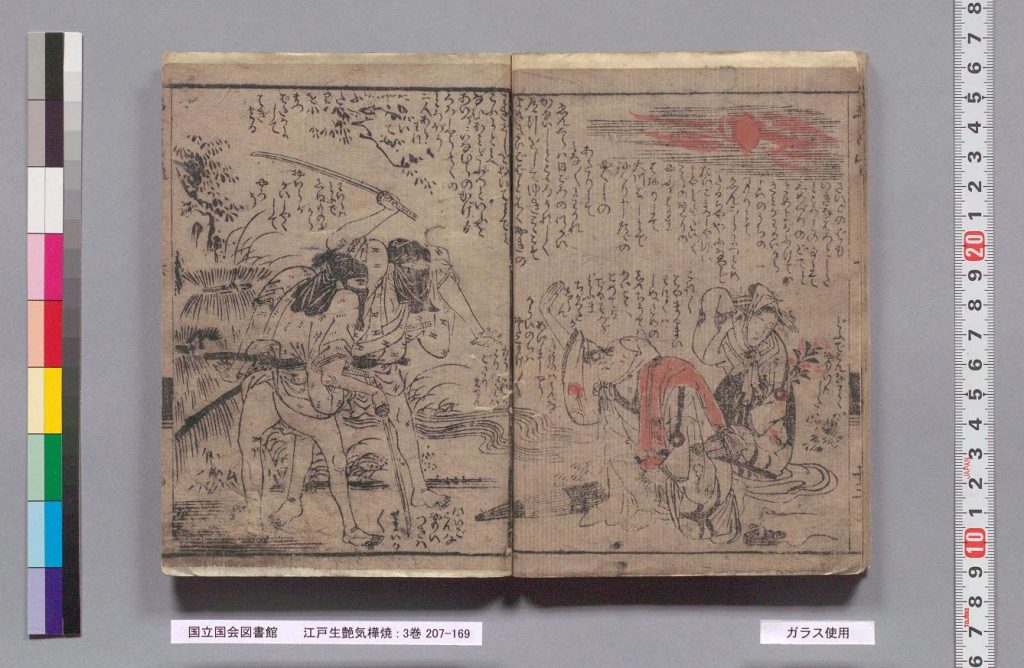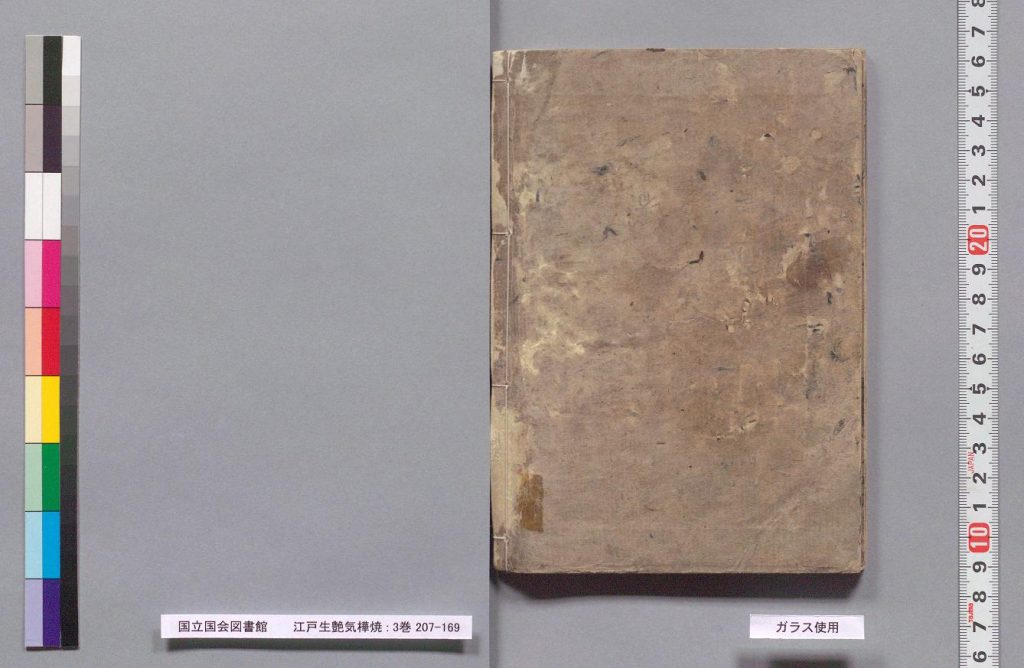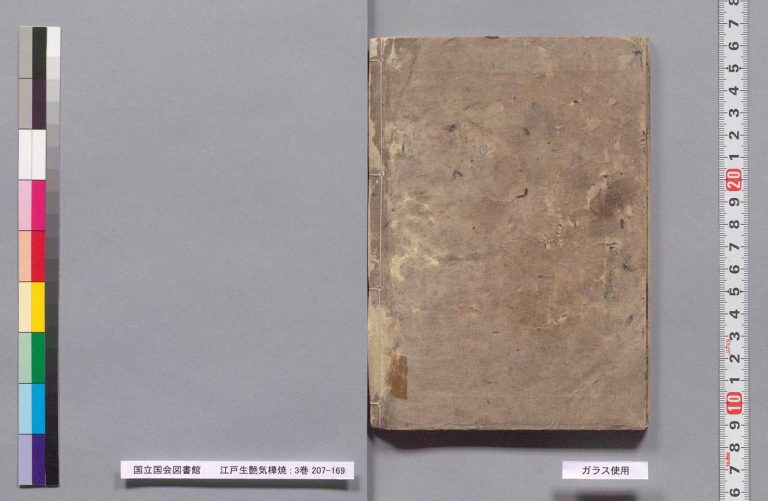Female Readership in Edo
By Daniela Baeumler
Abstract:
During the Tokugawa period (1603–1867), the range of literacy grew among Japan’s population. Not only the country’s elite but also wealthier townspeople’s children were sent to schools. The wider range of literacy led to a boom in the publishing industry. As one of the subcategories of gesaku (“playful writings”), kusazōshi featured illustrations and text of popular stories and were especially popular among women and children. These short publications of merely ten pages, mainly written in hiragana to reach a wide and possibly semi-literate audience. In this context, this paper aims to answer the question what role do tales (of popular fiction) play in the lives of women and girls in Edo?
Keywords: gesaku, Edo literature, publishing, popular fiction, illustrated books, entertainment, women literature
Introduction
Kornicki explains, “The history of books, of reading, of authorship, and even of education in Japan has overwhelmingly privileged the male experience, but . . . it is undeniable that women were a recognizable segment of the commercial market for books before the seventeenth century was over.”[1] During the Tokugawa period (1603–1867), the range of literacy grew among Japan’s population. Not only the country’s elite but also wealthier townspeople’s children were sent to schools (terakoya). The publishing of educational texts such as Onna Daigaku (“Greater Learning for Women”) took women’s literacy for granted and reading was a requirement of a good education. Chinese classics, biographies of exemplary women, moral texts of Confucian teachings provided young women not only with appropriate subjects they were supposed to have knowledge of but also give lessons on how to behave.[2] Apart from utilizing one’s ability to read for educational purposes, reading for pleasure also became more popular among the population. The wider range of literacy led to a boom in the publishing industry. In addition to already established Japanese and Chinese classics, popular fiction was developed in the form of gesaku (“playful writings”) which included a range of genres of fiction and fashion: sharebon (books of wit and fashion), kokkeibon (comic fiction), kibyōshi (satiric picture books), gokan (extended picture books), yomihon (historical supernatural fiction), and ninjōbon (sentimental fiction), kusazōshi (featuring illustrations and text). The latter were very short publications of merely ten pages, mainly written in hiragana to reach a wide and possibly semi-literate audience. These types of popular stories were especially popular among women and children.[3] In this context, this paper aims to answer the question what role do tales (of popular fiction) play in the lives of women and girls in Edo?
Characteristics of Edo Books (of Popular Fiction)
The hierarchical society of Edo was also reflected in its books: refined literature, e.g., Japanese and Chinese classics and medical texts, were generally established before the Tokugawa era and meant for and by the social elite; and popular literature which included illustrated (comic) fiction and new haiku poems, were meant for new readers like chōnin (townspeople).[11] “Physical characteristics of Edo books, in particular, size and cover decoration, are often associated with particular genres of the monographs and their hierarchical status.”[12] One characteristic that represented the status of certain book types was the use of syllabary. While most of the literature for men was written in Chinese, others especially books meant for children and women used kana.[13] Katakana had a higher status than hiragana which was demonstrated by its use in war stories which became popular in the Tokugawa era. “In addition to fictional war tales, which were written before the Edo period, a new type of fact-based historical war story was published. The new works were written in Chinese, often glossed or annotated with katakana . . . to indicate that these works were accurate historical chronicles.”[14]
Even though there was a variety of types of paper available, for mass-produced low-quality books publishers would usually utilize hangami (paper of low quality).[15] “Before the Edo period, paper was so valuable that only the limited elite classes could afford it. Paper was exclusively used for writing. As demand for paper grew, the production of mass-produced and inexpensive paper increased.”[16] The production of books entailed the cooperation of various specialised craftsmen. As Hioki explains, this included “a copyist to write a clean copy, a block-carver, a printer and a cover-maker who folded and trimmed pages, made covers and bound them together with the text block pages.”[17] Further cover-makers either worked independently or at publishers directly; they usually applied paper covers but fabric was sometimes utilized for manuscript books.[18]
Paper was also a product of the expansive waste business industry, as “Edo was the largest waste paper supplier.”[19] This business was organized under the government and included the sale of collected waste paper to papermakers who recycled it. This recycled paper was used in various forms, such as toilet paper, building materials, stationery and relevant here for book text paper and book covers. These were often sold to the market directly through wholesalers of recycled paper.[20] “There were several villages (communities) in the Edo region that made recycled paper. The first villages started at Asakusa, and moved to Sanyabori in the early nineteenth century, they then moved north to Senjyu in the twentieth century.”[21]
The wide range of genres or types of popular fiction, as highlighted in the Introduction, are often not easily distinguishable from each other. One of the largest categories under the term gesaku are kusazōshi (“grass books”) that are named after the grass style of calligraphy.[22] These publications are picture books, “approximately seven inches high and five inches wide and consisting of one to three booklets, each containing five leaves (ten pages).”[23] This type of book highly relied on the cooperation of the author and the artist, as they involved the interaction of text with illustrations. These books were primarily written in hiragana enabling a large number of readers to enjoy the works. Due to the importance of the images which conveyed the story, it is also likely that not all readers were fully literate, or semi-literate in only one syllabary. Another possibility to enjoy the books without literacy is the practice of being read to as it was quite common in Edo, e.g., the reading out of newspapers.[24] “The kusazōshi may well have been the first vastly popular comicbook—and the kibyōshi, which flourished from 1775-1806, perhaps even the first such comicbook for adults—in world literary history.”[25]
“Coloured covers for popular fiction often gave their name to certain genres.” These coloured covers were red-covered books (akahon), black-covered books (kurohon), blue-covered books (aohon) and yellow-covered books (kibyōshi).[26] “The earliest examples, with rather crude linear illustrations and a minimum of verbal text, were appropriate fare for children and semi-literate adults.” These akahon included folk tales, fables, and legends,[27] and they first appeared around 1670 but larger quantities were printed from around 1720.[28] These early kusazōshi were replaced by the kurohon in the 1740s which contained stories “of more adult subject matter such as war tales and puppet theatre text (jōruri).”[29] Similarly, the kibyōshi took over the aohon position, creating satiric and didactic tales. This type of literature was popular between 1775 and 1806 and employed ukiyo-e style illustrations[30] And “many of the leading ukiyo-e artists of the Torii, Katsukawa, Kitao, and Kitagawa schools were involved in illustrating kusazōshi like the kibyōshi.”[31]
“One type of popular illustrated fiction, known as a combined book (gōkan) from the nineteenth century, featured elaborate multicoloured woodblock-illustrated covers.”[32] These books were generally combinations of previously published kusazōshi in combined books to minimize the binding cost.[33]
Copyright, Censorship and Control
With the spread of literacy came the growth of readership. Additionally, the decline of the patronage system encouraged “competition between urban and rural booksellers, debates pitting the universal accessibility of ideas against proprietorship over their expressive form”[34] and the emergence of new rights, such as the copyright. “The role of the state in the print revolution was complex. On the one hand, the Tokugawa Bakufu supported printing and encouraged the commercial printing sector. On the other hand, a severe censorship policy was imposed.”[35] As an effort to promote education and literacy, the Tokugawa shogunate played an important role in the establishment of publishing culture in early modern Japan. The earliest attempt at controlling the content of books was the edict of 1630, which prohibited books on Christianity. The institutionalizing of censorship and control of copyright followed in 1722, controlling the publications on grounds of “disruptive of public peace” and “injurious to public morals.”[36] As part of Tokugawa Yoshimune’s 徳川吉宗 (1684–1751) Kyōhō Reforms, it was required to publish the author’s name and “a program of internal censorship through the publishers’ guilds (hon’ya nakama 本屋仲間)” was instigated.[37] However, “in practice this was not uniformly carried out, and the extent to which it was actually enforced has been overstated.”[38] For example, the topic of politics, especially contemporary politics, was not permitted as a matter to be published, “even if it was in fact supportive of the government.”[39] Furthermore, an interview with a machi bugyō 町奉行 (town magistrate) mentioned the screening by city officials of ezōshi. “Without the permission of the machi bugyō, they could not be printed.”[40] He explained further that this was mainly to prevent the publicization of “salacious pictured or pictures satirizing the authorities.”[41] Yet, through the use of pseudonyms for political figures, authors were able to escape these censorship roles.[42]
In general, the censorship of popular fiction, particularly that of kusazōshi, showed barely any regulation.[43] Kusazōshi were not deemed offensive because they primarily served as entertainment for children, regardless of possibly encompassing mature content.[44] There were also additional factors that might have influenced the comparatively soft regulations on these types of books. As “censorship was to be carried out internally through the publishing guilds, which were formally recognized by the shogunate only for more elite categories of book (mono no hon 物の本) at the time of the reforms,”[45] kusazōshi fell under the jurisdiction of the “local book” (jihon 地本) publisher-wholesalers’ guild, which was only recognized later in 1790 during the Kansei reforms of Matsudaira Sadanobu (1759–1829).[46] Nakano also argued the purpose for these regulations was to serve as protection against piracy instead of a repressing matter.[47] Therefore, “kusazōshi and other ‘local books,’ which were published only in Edo, did not suffer the same piracy threats as books published in multiple cities.”[48] This would have also made the inclusion of the author’s name irrelevant. Restrictive measures of the reforms of the Kansei era (1789–1808) placed more importance for works of popular fiction on upholding the rules of not being “disruptive of public peace” and “injurious to public morals.” This resulted in authors, such as Santō Kyōden (1761–1816), adjusting their writing style, particularly the expression of humour, to avoid trouble with the shogunate.[49] This especially applied to sharebon, books that showed realistic depictions of the pleasure quarter and its customs and interactions.[50]
Violence, on the other hand, did not seem to be an issue in popular literature, even among children’s books. While media violence seems to be a common concern for parents today, it did not seem relevant in early modern Japan. Indeed, Edo novelist Kyokutei Bakin 曲亭馬琴 (1767–1848) that “the lack of violence in contemporary children’s literature was the real cause for concern.”[51]
Distribution of Books in Edo
As already indicated in Characteristics of Edo Books (of Popular Fiction), kusazōshi were rather short, containing only 10 pages. Therefore, it often took more than one volume to complete a tale. In the progress of publishing these tales, “as stories lengthened, two or three fascicles were combined into one volume,”[52] creating additional publications called gōkan. The creation of kusazōshi involved very low costs as the publishers focused on high volumes and smaller book sizes. With few exceptions, publishers usually issued only a small number of copies at a time and printed repeatedly over a long period of time, sometimes up to one-hundred years, using the same woodblocks.[53] Because of this inexpensive production cost involved in creating kusazōshi, these types of books were “revolutionary publications in book marketing.”[54] Before the emergence of kusazōshi, the prices of books were so high that most of the population acquired most books lending libraries because they could not afford to buy them. The development of kusazōshi enabled growth in readership, as the cost of a kusazōshi book, e.g., a yellow-covered book, was estimated to be around twenty times less than the price of a refined text. In fact, they were so affordable “their cost was less than half that of an average person’s lunch.”[55] In detail, the emergence of kusazōshi shifted the publishing sector’s customers from few lending libraries to many individual customers. In addition to popular fiction, as the literacy levels rose, Japanese and Chinese classics were still available through lending libraries “which operated for profit (and continued to do so into the late nineteenth century), enabled city residents to read a wider range of works than they could afford to own. There was thus greater access to knowledge among a wider range of people, men and women, than at any prior time.”[56]
Portrayal of Women Readers
Apart from books directly aimed at or advertised for women and girls, diaries or memoirs by women that give insight into the reading habits of the author, one important source of depictions of women as a group of readers is through paintings and illustrations, in particular ukiyo-e.[57] Itasaka Noriko elaborates that the portrayal of women in illustrated forms depended on the time period and moved from presenting higher status women to a more commoner-based readership.[58] Accordingly, “the women readers depicted in prints changed over time, from upper-class women reading waka . . . (in the late seventeenth and early eighteenth century), to courtesans reading the classics as well as popular novels, guidebooks, and picture books (kusazōshi) . . . (in the second half of the eighteenth century), to commoner girls reading conduct manuals and popular educational texts (toward the end of the eighteenth to mid-nineteenth century).”[59]
The author Hishikawa Moronobu 菱川師宣 (1618–1694) often presented illustrations of women reading Japanese classics in his books. In Figure 1, for example, above an illustration of women reading, he wrote about women enjoying classics such as Kokinshū, Man’yoshū, Ise monogatari and Genji monogatari.[60]
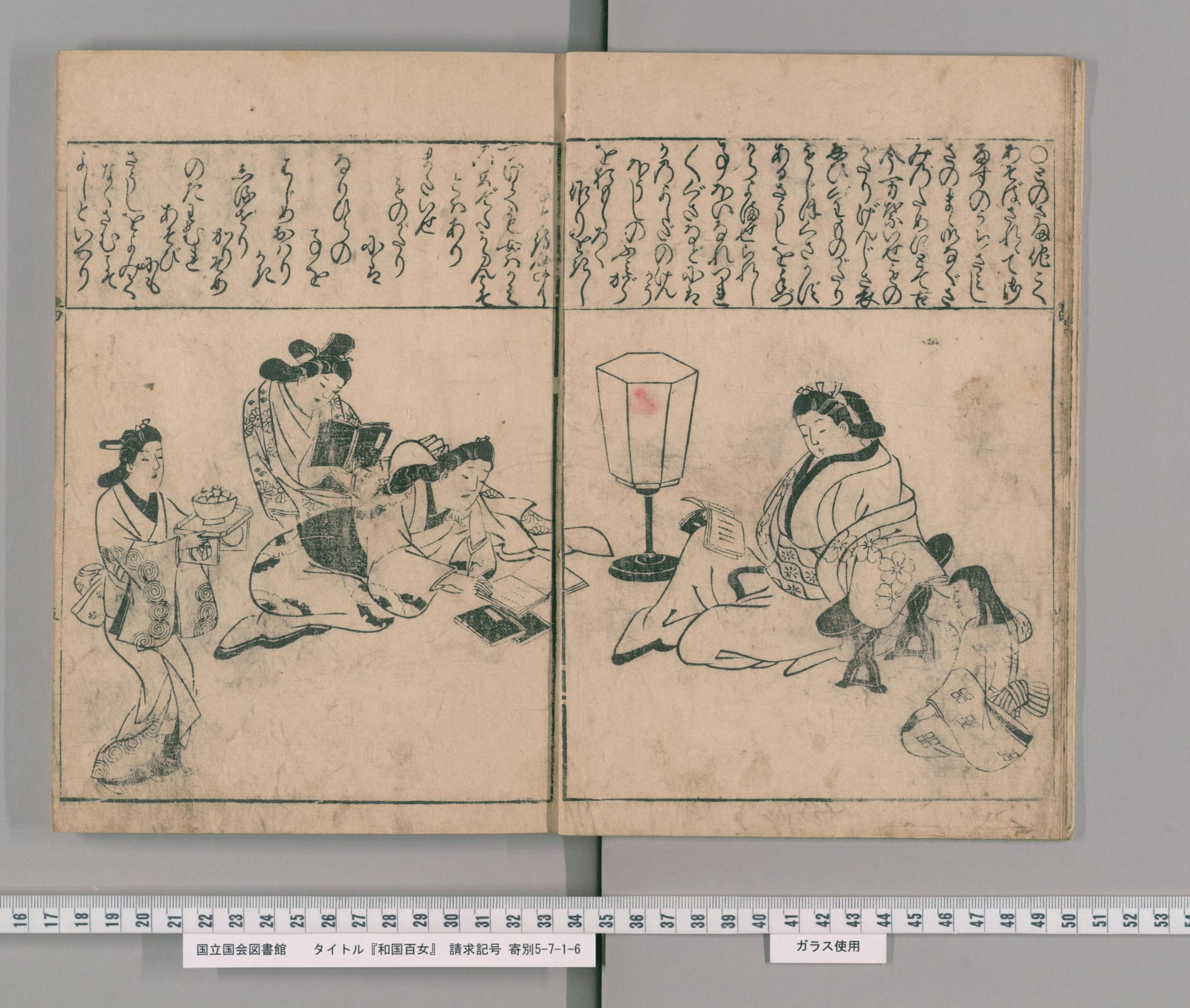
Popular Fiction: Examples and Controversy
Peter Kornicki explains “In seventeenth-century Japan, commercial publishers issued hundreds of titles that gained favor among what must have been a large constituency of readers.”[61] One controversy on women and children’s literature in Tokugawa Japan followed the appropriateness of classics of the Heian period, “especially Genji monogatari and Ise monogatari, and the tradition of court poetry, that gave rise to anxiety.”[62] Sinologists held the opinion concerning Genji and Ise monogatari as “unsuitable” for children and women, especially in the later seventeenth century.[63] They proceeded to write outlines how to teach children, some agreeing to read Japanese texts along with Chinese, others not. Opinions were particularly split on the poems in Genji monogatari.[64] However, while they were considered lewd and therefore unsuitable, no attempt was made to ban or censor them, and distribution through print was tolerated.[65] The debate over the appropriateness of the two tales was essentially resolved around the mid-eighteenth century—with the result of Genji and Ise monogatari as suitable for children and women—and was only taken up again in Meiji Japan.[66] “Women in the Tokugawa period of whom we have record made no attempt to conceal their reading of Genji and in some cases implicitly rejected the arguments of the detractors.”[67] Kornicki elaborates on the case of Nonaka En 野中婉 (1660–1725), the daughter of a senior retainer of the daimyo of Tosa. She saw great importance in young women paying attention to books “that could teach them valuable moral lessons” instead of being consumed by fashion trends. While this might refer to more obvious publications on moral teachings, such as conduct books, she did recommend Tsurezuregusa and Genji monogatari.[68] Similarly, in accounts of both women working in the ōoku (“inner quarter” of the Edo palace) and the wife of a daimyo, they stressed the importance and popularity of Genji.[69] The three texts of the Heian period, Hyakunin isshu, Ise monogatari, and to a lesser extent Genji monogatari, were “packaged” for women readership in Tokugawa Japan.[70] “The Hyakunin isshu was a fundamental part of feminine education from the late seventeenth century onward,” and different to the two tales the moral qualities of the poems contained in Hyakunin isshu were not questioned until the Meiji era.[71] Mostow argues that some annotated and illustrated publications were specifically catered towards women. However, he also points out that there is no proof that women outside of higher-ranking samurai families and aristocracy, enjoyed Heian classics during this time. He also identified the representation of women readers in illustrations (as elaborated in Portrayal of Women Readers) as a basis for changes in female readership.[72]
Concerning the term “popular” I follow Moretti’s view as something well-liked and consumed by many. As this might be difficult to grasp for early modern environments, Moretti orientates her studies around quantitative clues of the publishing industry, such as the number of titles (re)printed, the involvement of publishers and the books’ circulation.[73] However, these numbers cannot convey appropriately who the reader was or who was enjoying the book. As “illiteracy was generally much higher among women than men,”[74] men constituted the main readership in Edo and therefore accordingly they were the ones buying the books. Another factor, addressed by Kern, is the adaptation into kabuki theatre. In this context, he mentions two bestselling kibyōshi: Santō Kyōden’s 山東京伝 (1761–1816) Edo umare uwaki no kabayaki 江戸生艶気蒲焼 (Playboy, Roasted à la Edo; 1785) and the story of the forty-seven loyal retainers, which had received multiple kabuki versions. But the original Kanadehon chūshingura 仮名手本忠 臣蔵 (The Treasury of Loyal Retainers) by Takeda Izumo 竹田出雲 (1691–1756) was for puppet theatre.[75] Other popular novelists included, for instance, Tamenaga Shunsui 為永春水 (1790–1844) and Jippensha Ikku 十返舎 一九 (1765–1831).
Santō Kyōden’s Playboy, Roasted à la Edo, 1785: This story is a comic book about a kabuki fan Enjirō who admires a famous kabuki actor and foolishly attempts a fake double suicide.




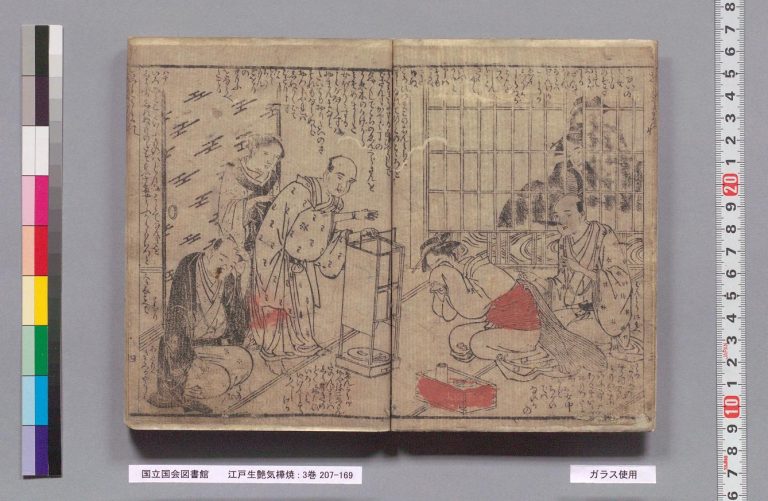
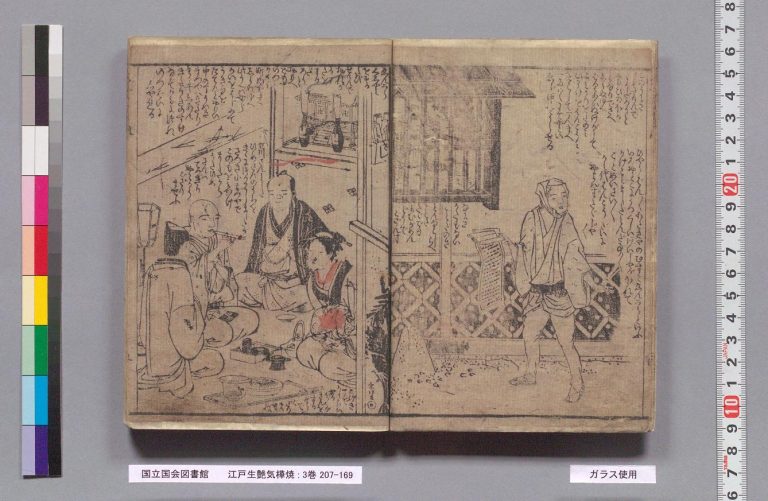

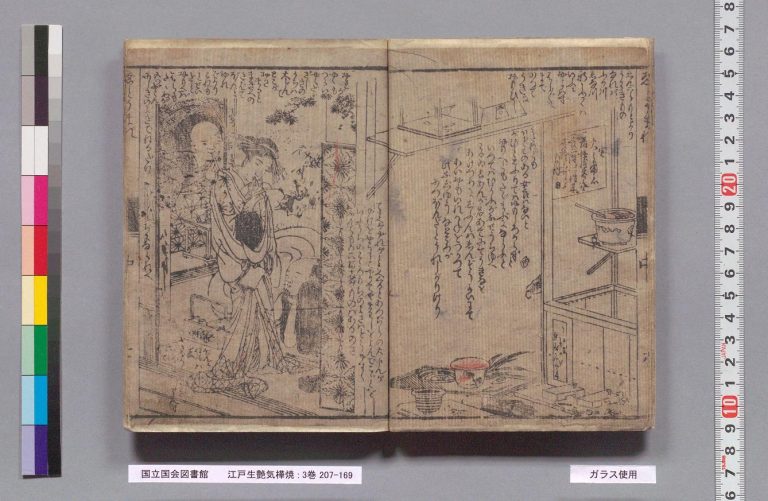
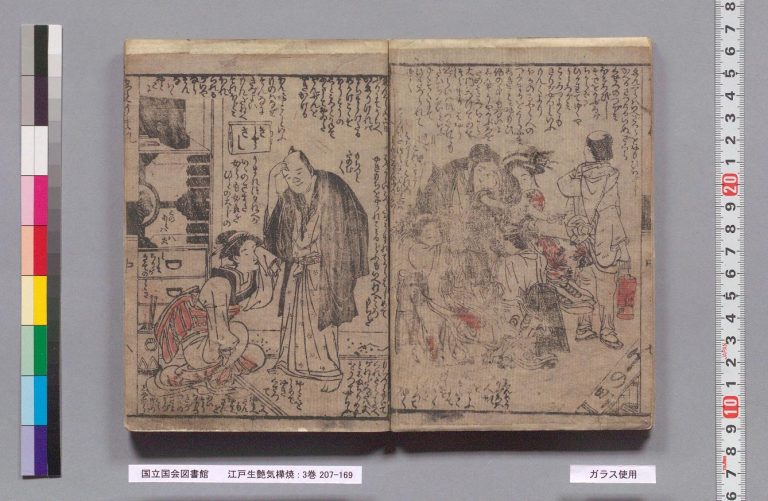

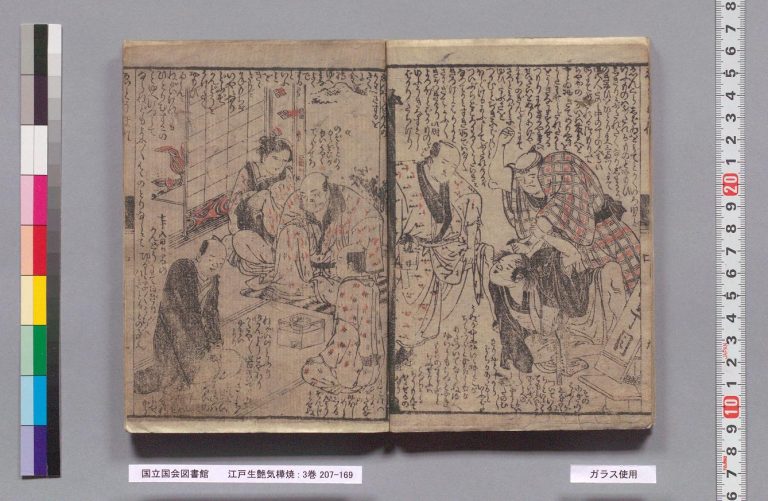

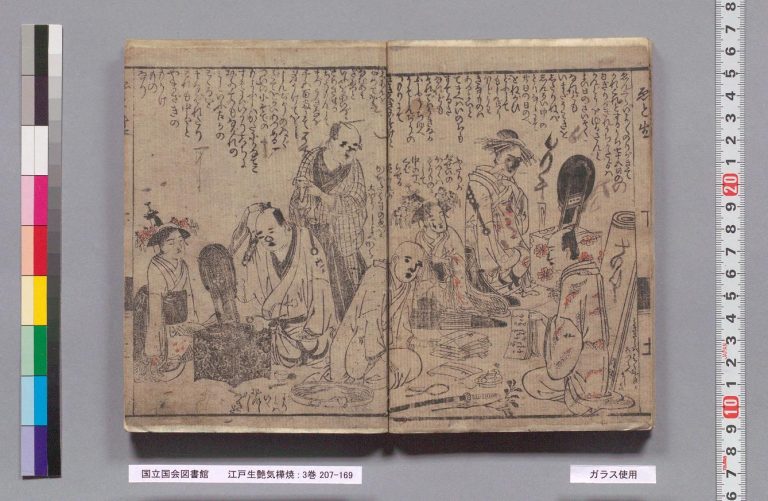
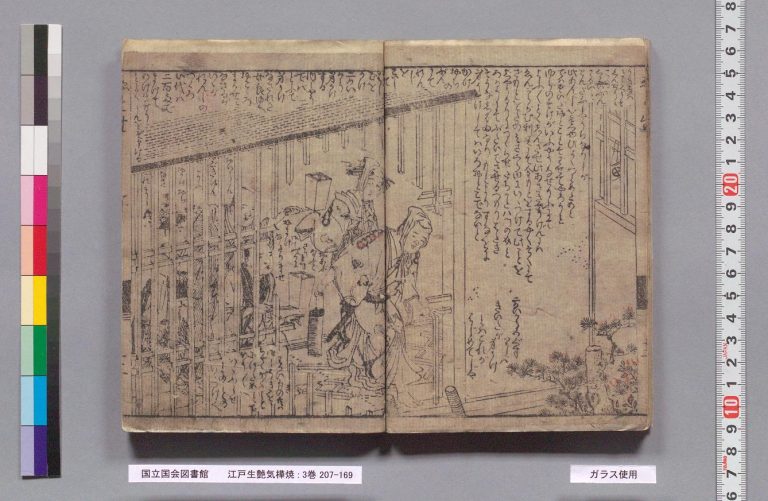


Purpose: Educational Entertainment
Education of daughters of samurai and wealthy townspeople in Edo tended to follow trends of the aristocracy. As a result, as pointed out in the previous section, waka played an important role in girls’ education.[76] Conduct manuals of Confucianist practices, such as Onna daigaku 女大学 (Greater Learning for Women) or Onna daigaku takarabako 女大学宝箱 (Treasure Chest of Greater Learning for Women), on the other hand, portrayed things that girls and women are supposed to do or be proficient in. Subjects were conveyed in a moralistic voice and served the purpose of self-cultivation.[77] In a similar effort, biographies of exemplary women provided further explanations on appropriate behaviour by providing tales of women’s (fictional) experiences. For example, stories revolving the topic of filial piety showed devotion towards the men in the women’s lives, i.e., husbands, fathers, sons, and teachers, and depicted virtuous women performing self-sacrifices and committing suicide. These themes are often connected to Buddhist subjects. Another common action is violent revenge which is displayed in one example of an almost certainly fictional story of a girl named Riya.[78] Her father was killed by an intruder who was infatuated with Riya’s mother. After her father’s death, her mother died in grief. Riya grew up planning to avenge her parents’ death and therefore sought out training in swordsmanship. When she was deemed ready, she received the official approval by the shogunate and the domain’s daimyo to duel her parents’ killer and kill him. She proceeded to do so, and the daimyo was so impressed he made her lady-in-waiting for his daughter.[79] These stories contrast the reality of women’s behaviour depicted in diaries and memoirs and regarded as filial. So, “for all that tales of exemplary women and their later dramatic and fictional interpretations tell us about norms, ideals, and aspirations regarding . . . behavior, they are in essence narrative inventions intended to inspire and entertain.”[80] This demonstrates that not only tales labelled as ‘popular fiction’ are forms of entertainment, but stories meant to educate, too, can be read for pleasure.
Conclusion
Edo’s hierarchical society was also reflected in its books: refined literature, such as Japanese and Chinese classics and medical texts, was for the elite of society, established before the Tokugawa period, while popular literature, such as illustrated novels and new haiku, was for new readers, such as the townspeople. Apart from Heian literature which was seen as a necessity for aristocratic girls and therefore tended to inspire trends among lower-status samurai’s as well as wealthy townspeople’s women and daughters, depictions in illustrations, memoirs, diaries, and annotations indicate that some books of popular fiction were indeed catered towards women—even women of higher status can be seen in images reading tales of popular fiction. Regarding educational literature, conduct manuals and biographies of successful women, even though the stories of exemplary women and subsequent interpretations of drama and fiction can teach us about norms, ideals and aspirations regarding behavior, they are essentially narrative creations for the purpose of inspiration and entertainment. This shows that in Tokugawa Japan women did not only enjoy tales labelled as ‘popular fiction’ for entertainment, but also tales meant to educate.
[1] Kornicki et al. 2010, p. 2.
[2] Yonemoto 2016.
[3] Hioki 2009. Kimbrough elaborates on the definition of “child” in the context of Japan as the boundaries are not as clear. Many scholars define “child” as a solely Western construct. Therefore, the “status, or even presence, of children’s literature in premodern Japan is controversial among scholars today” (Kimbrough 2015, p. 113).
[4] Hioki 2009, p. 80.
[5] Yonemoto 2016, p. 18.
[6] Yonemoto 2016, p. 61.
[7] Hioki 2009, p. 80.
[8] Hioki 2009, p. 80.
[9] Kamei-Dyche 2011, p. 275.
[10] Yonemoto 2016, p. 204.
[11] Hioki 2009, p. 83.
[12] Hioki 2009, p. 92.
[13] Kamei-Dyche 2011, pp. 270–72.
[14] Hioki 2009, p. 83.
[15] “While very little is known about hangami, in his Kamisuki hitsuyō of 1836, Ōkura Tsunenaga described the process (as one) in which time-consuming steps such as handpicking specks and washing were omitted.” Hioki 2009, p. 85.
[16] Hioki 2009, p. 84.
[17] Hioki 2009, p. 87.
[18] Hioki 2009, p. 87.
[19] Hioki 2009, p. 88.
[20] Hioki 2009, p. 88.
[21] Hioki 2009, p. 88.
[22] Araki 1970, p. 45.
[23] Araki 1970, p. 45.
[24] Kimbrough 2015, p. 113.
[25] Kern 2011, p. 168.
[26] Hioki 2009, p. 90.
[27] Araki 1970, p. 45.
[28] Araki 1970, p. 46.
[29] Hioki 2009, pp. 97–98.
[30] Hioki 2009, pp. 97–98.
[31] Kern 2011, p. 172.
[32] Hioki 2009, p. 90.
[33] Hioki 2009, p. 98.
[34] Atherton 2020, p. 48.
[35] Kamei-Dyche 2011, p. 276.
[36] Suzuki 2012, p. 8.
[37] Atherton 2020, p. 50.
[38] Kamei-Dyche 2011, p. 276.
[39] Kamei-Dyche 2011, p. 276.
[40] Beerens 2002, p. 185.
[41] Beerens 2002, p. 185.
[42] Kamei-Dyche 2011, p. 276.
[43] Atherton 2020, p. 50.
[44] Atherton 2020, p. 51.
[45] Atherton 2020, p. 51.
[46] Atherton 2020, p. 51.
[47] Nakano 2011, pp. 45–46.
[48] Atherton 2020, p. 51; Nakano 2011, pp. 45–46.
[49] Munakata 2012, p. 27.
[50] Munakata 2012, p. 28.
[51] Kimbrough 2015, p. 133.
[52] Hioki 2009, p. 98.
[53] Hioki 2009, pp. 80–81.
[54] Hioki 2009, p. 98.
[55] Hioki 2009, p. 98.
[56] Kamei-Dyche 2011, p. 276.
[57] Yonemoto 2016.
[58] Itasaka 2010, pp. 104–105.
[59] Yonemoto 2012, p. 805.
[60] Kornicki 2005, p. 169.
[61] Moretti 2020, p. 7.
[62] Kornicki 2005, p. 148.
[63] Kornicki 2005, pp. 152–53.
[64] Kornicki 2005, pp. 154–56.
[65] Kornicki 2005, p. 162.
[66] Mostow 2010, p. 59.
[67] Kornicki 2005, p. 167.
[68] Kornicki 2005, p. 167.
[69] Beerens 2008, p. 307; Shiba 2020, p. 120.
[70] Mostow 2010, p. 60.
[71] Mostow 2010, p. 83.
[72] Mostow 2010, pp. 65–66.
[73] Moretti 2020, p. 15.
[74] Rubinger 2007, p. 68.
[75] Kern 2011, pp. 168–69.
[76] Mostow 2010, p. 59.
[77] Rubinger 2007, p. 117; Yonemoto 2010, p. 53.
[78] Yonemoto 2016, pp. 24–32.
[79] Yonemoto 2016, pp. 32–36.
[80] Yonemoto 2016, p. 37.
References
Araki, James T. “The Dream Pillow in Edo Fiction 1772-81.” Monumenta Nipponica 25:1/2 (1970), pp. 43–105.
Atherton, David C. “The Author as Protagonist: Professionalizing the Craft of the Kusazōshi Writer.” Monumenta Nipponica 75:1 (2020), pp. 45–89.
Beerens, Anna. “Interview with a Bakumatsu Official: A Translation from Kyūji Shimonroku (2). Monumenta Nipponica 57:2 (2002), pp. 173–206.
Beerens, Anna. “Interview with Two Ladies of the Ōoku: A Translation from ‘Kyūji Shimonroku.’” Monumenta Nipponica 63:2 (2008), pp. 265–324.
Berry, Mary Elizabeth. Japan in Print: Information and Nation in the Early Modern Period. University of California Press, 2006.
Davis, Julie Nelson. Partners in Print: Artistic Collaboration and the Ukiyo-e Market. University of Hawai´i Press, 2015.
Hioki Kazuko. “Japanese printed books of the Edo period (1603–1867): history and characteristics of block‐printed books.” Journal of the Institute of Conservation 32:1 (2009), pp. 79–101.
Itasaka Noriko. “The Woman Reader as Symbol: Changes in Images of the Woman Reader in Ukiyo-e.” In The Female as Subject: Reading and Writing in Early Modern Japan, ed. Peter F. Kornicki, Mara Patessio, and G. G. Rowley, pp. 87–109. University of Michigan Press, 2010.
Kamei-Dyche, Andrew T. “The History of Books and Print Culture in Japan: The State of the Discipline.” Book History 14 (2011), pp, 270–304.
Kern, Adam L. “Kabuki Plays on Page—and Comicbook Pictures on Stage—in Edo-Period Japan.” In Publishing the Stage: Print and Performance in Early Modern Japan, ed. R. Keller Kimbrough and Shimazaki Satoko, pp. 163–89. University of Colorado Center for Asian Studies, 2011.
Kern, Adam L. Manga from the Floating World: Comicbook Culture and the Kibyōshi of Edo Japan, Second Edition. Harvard University Asia Center, 2019.
Kimbrough, R. Keller. “Bloody Hell!: Reading Boys’ Books in Seventeenth-Century Japan.” Asian Ethnology 74:1 (2015), pp. 111–39.
Kobayashi Hisako. “Publishing Networks in Edo Japan.” MA Thesis, 2015.
Kornicki, Peter F. The Book in Japan: A Cultural History from the Beginnings to the Nineteenth Century. University of Hawai‘i Press, 2001.
Kornicki, Peter F. “Unsuitable Books for Women? ‘Genji Monogatari’ and ‘Ise Monogatari’ in Late Seventeenth-Century Japan.” Monumenta Nipponica 60:2 (2005), pp. 147–93.
Moretti, Laura. Pleasure in Profit: Popular Prose in Seventeenth-Century Japan. Columbia University Press, 2020.
Mostow, Joshua S. “Illustrated Classical Texts for Women in the Edo Period.” In The Female as Subject: Reading and Writing in Early Modern Japan, ed. Peter F. Kornicki, Mara Patessio, and G. G. Rowley, pp. 59–87. Ann Arbor: University of Michigan Press, 2010.
Munakata Kazushige. “Aspects of Suppression and Resistance.” In Ken’etsu, media, bungaku: Edo kara sengo made 検閲・メディア・ 文学: 江戸から戦後まで, ed. Suzuki Tomi 鈴木登美, Toeda Hirokazu 十重田裕一, Hori Hikari 堀ひかり, Munakata Kazushige 宗像和重, pp. 24–32. Shin’yōsha, 2012.
Nakano Mitsutoshi 中野三敏. Wahon no susume: Edo o yomitoku tame ni 和本のすすめ: 江戸を読み解くために. Iwanami Shoten, 2011.
Rubinger, Richard. Popular Literacy in Early Modern Japan. University of Hawai’i Press, 2007.
Satō Yukiko 佐藤至子. “Edo kōki gesaku no ken’etsu” 江戸後期戯作の検閲. In Ken’etsu, media, bungaku: Edo kara sengo made 検閲・メディア・ 文学: 江戸から戦後まで, ed. Suzuki Tomi 鈴木登美, Toeda Hirokazu 十重田裕一, Hori Hikari 堀ひかり, Munakata Kazushige 宗像和重, pp. 44–53. Shin’yōsha, 2012.
Shiba Keiko, trans. Anne Walthall. “Building Networks on the Fly: The Travails of Travel for Domain Lords’ Women.” In Women and Networks in Nineteenth-Century Japan, ed. Bettina Gramlich-Oka, Anne Walthall, Fumiko Miyazaki, Noriko Sugano, pp. 113–42. University of Michigan Press, 2020.
Suzuki Tomi. “History and Issues in Censorship in Japan.” In Ken’etsu, media, bungaku: Edo kara sengo made 検閲・メディア・ 文学: 江戸から戦後まで, ed. Suzuki Tomi 鈴木登美, Toeda Hirokazu 十重田裕一, Hori Hikari 堀ひかり, Munakata Kazushige 宗像和重, pp. 7–23. Shin’yōsha, 2012.
Takagi Gen 高木元. Kusazōshi o kenkyūsuru koto 草双紙を研究すること. https://fumikura.net/other/kusa_int.html.
Tinios, Ellis. “Japanese Illustrated Erotic Books in the Context of Commercial Publishing, 1660-1868.” Japan Review 26 (2013), pp. 83–96.
Tsuda Mayumi 津田眞弓. “Edo ehon no asobi: Kusazōshi ‘Gozonji no shōbaimono’ o dō yomu ka” 江戸絵本の遊び:草双紙「御存商売物」をどう読むか. The Hiyoshi Review of the Humanities 慶應義塾大学日吉紀要人文科学 30 (2015), pp. 85–117.
Wakabayashi, Judy. “Foreign Bones, Japanese Flesh: Translations and the Emergence of Modern Children’s Literature in Japan.” Japanese Language and Literature 42:1 (2008), pp. 227–55.
Yonemoto, Marcia. “Women, Words, and Images in Early Modern and Modern Japan.” Journal of the Economic and Social History of the Orient 22:4/5 (2012), pp. 802–816.
Yonemoto, Marcia. The Problem of Women in Early Modern Japan. University of California Press, 2016.
Yonemoto, Marcia. “Outside the Inner Quarters: Sociability, Mobility and Narration in Early Edo-Period Women’s Diaries.” Japan Forum 21:3 (2010), pp. 389–401.

